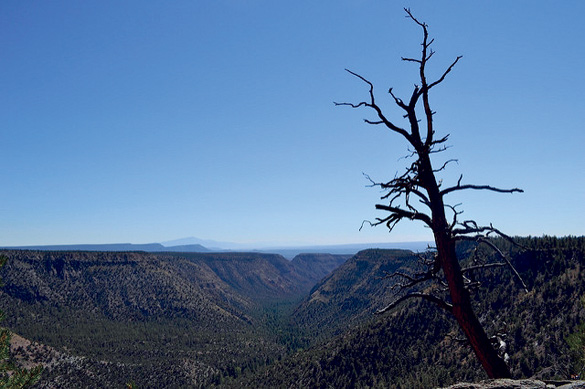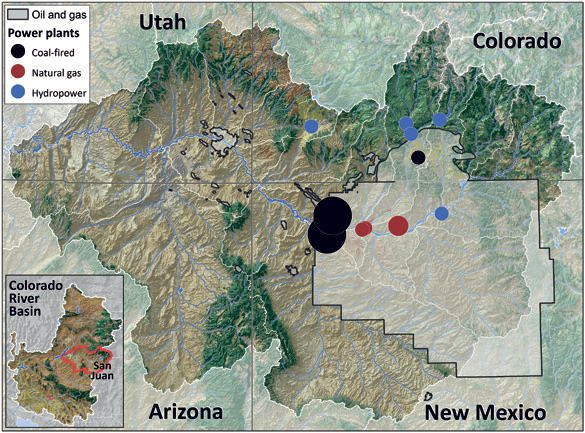 A tree just down canyon from Richard Middleton’s house. Photo by Richard Middleton
A tree just down canyon from Richard Middleton’s house. Photo by Richard Middleton San Juan and Colorado River basins. The San Juan River basin is host to a range of complex climate, disturbance, and energy-water challenges. The basin supplies water for multiple gas and coal-fired power plants and hydropower, vast oil and gas production, widespread irrigation, and urban areas. Courtesy photo
San Juan and Colorado River basins. The San Juan River basin is host to a range of complex climate, disturbance, and energy-water challenges. The basin supplies water for multiple gas and coal-fired power plants and hydropower, vast oil and gas production, widespread irrigation, and urban areas. Courtesy photoLos Alamos Daily Post
A Los Alamos National Laboratory project was included in a White House celebration of the 23rd annual United Nations World Water Day Tuesday.
The White House hosted a Water Summit, including demonstrations, exhibitions, announcements and revelations intended to spotlight creative solutions and transform the way we think about solving the water problems today and tomorrow.
The full LANL project is half-way through a three-year $3 million Critical Watershed program, funded by a LDRD (Lab Directed Research and Development) grant.
The principal investigator, Richard Middleton is an expert in energy infrastructure modeling.
In an interview this week, he said the overall impetus came out of the lab’s research in the energy-water nexus, a Department of Energy priority that has investigated the multiple links between water and energy production.
The LANL project plans a data-mining assault on the full extent of the Colorado River, basin wide flows for multiple climate and disturbance scenarios out to the year 2100.
Already, they have accumulated a factual basis for calculating the toll that climate driven disturbances (temperature/drought, wildfire and insect infestation) will impose on forests.
The additional burdens on the environment, the LANL researchers have discovered will lead to negative climate feedbacks that would be half again greater than human-caused emissions.
One part of the overall program was led by Katrina Bennet, focused on a single representative watershed, the San Juan River in the Four Corners Region and is the basis of the work that will appear in the White House exposition.
She is also the lead author of an article in preparation for the Journal Nature Climate.
The project also includes contributions by Nate McDowell, LANL’s well-known climate researcher who has specialized in plant survival and mortality during drought.
His work on tree mortality, previously published, has been applied in this case to the hydrological analysis.
A remarkable finding uncovered by the research was that future climate change scenarios applied to the San Juan River watershed indicate that yearly water flows from the San Juan into the Colorado River will increase by 6 percent, but that forest cover disturbances will significantly reduce the flows (varying between 4 percent and 14-18 percent).
This difference becomes more pronounced from 2050 and later when the climate-disturbances are timetabled to become stronger.
The differences in these impact scenarios are also significant, because they reflect the strong influence of disturbed forest lands on water flow.
This project believes this “will likely have a huge impact on how we understand the energy- water nexus.”
The full project, according to a laboratory bulletin is working to understand and quantify the impact of disturbances on watersheds, ranging from fine-scale analysis of several square kilometer watersheds up to a regional sale analysis of the entire Colorado River.
So far we see superficial effects of climate-change’s double whammy, like wildfire, the scientists say, but more disruptive forces, like temperature –drought mortality and insect infestation may well be lurking a little farther down the road.
The hook for participating in the White House summit, Middleton said, was “how climate is going to impact the water.”
In fact the laboratory’s Critical Watersheds project has identified an ominously emerging multiplier effect that will greatly alter climate-change prediction and require rethinking a climate strategy still in its infancy.

